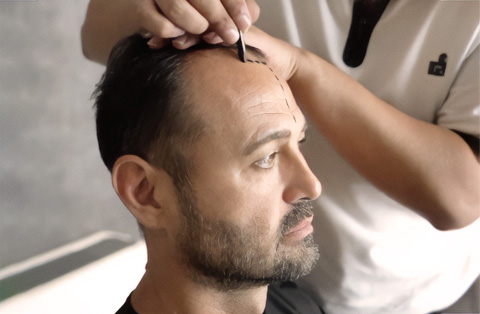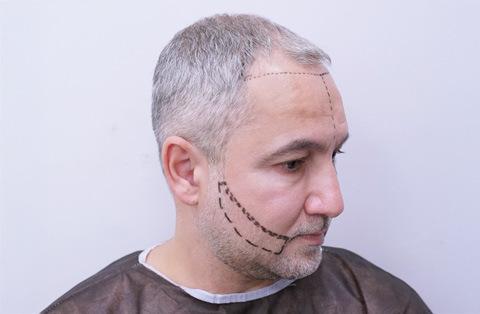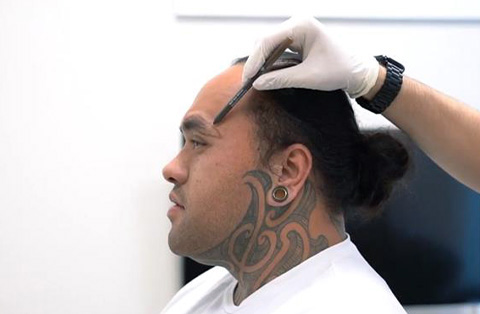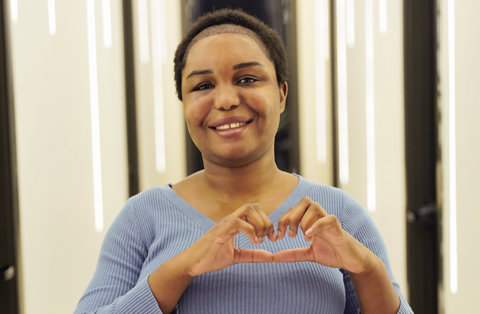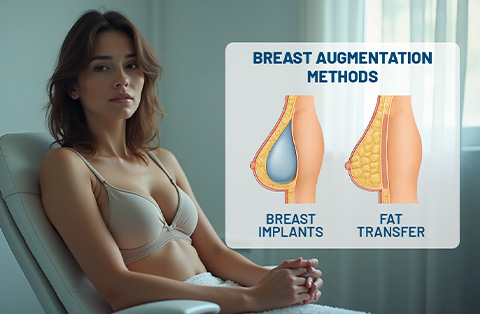Struggling with thinning hair? Learn the causes, patterns, and proven treatments for female hair loss. Discover how early diagnosis and the right care can protect and restore your hair’s natural look.
What Are the Common Types of Hair Loss in Women?
Hair loss in women can have different patterns and causes. It does not always follow the same pattern seen in men. Some types are temporary and related to hormonal or physical changes. Others can be progressive and permanent if not treated early. Recognizing the type of hair loss is the first step to choosing the right treatment.
Here are the most common types of female hair loss:
Androgenetic Alopecia (Female Pattern Hair Loss):
This is the most common type. It causes thinning on the top and crown of the scalp. The hairline usually stays the same. It often starts after menopause but can begin earlier. Genetics and hormones play a key role.
Telogen Effluvium:
This type causes sudden and widespread thinning. It usually starts a few months after a physical or emotional stress like illness, surgery, childbirth, or severe dieting. It is often temporary and improves once the cause is treated.
Alopecia Areata:
An autoimmune condition that causes patchy hair loss. The immune system attacks the hair follicles. It can affect the scalp or other parts of the body. It often starts suddenly and may return over time. Learn more about Alopecia Areata.
Traction Alopecia:
This happens when hair is pulled too tightly over time. It is common with tight hairstyles like ponytails, braids, or extensions. If caught early, hair can grow back. If not, it can cause permanent damage.
Cicatricial Alopecia (Scarring Alopecia):
This is a group of rare disorders that destroy hair follicles and cause scarring. Hair loss is usually permanent. It can occur with itching, burning, or pain. Early diagnosis is important to stop progression.
Anagen Effluvium:
This type happens during the growth phase of hair. It often results from chemotherapy or radiation. Hair loss is usually rapid but can be reversible once treatment ends.
Each type needs a different approach. Correct diagnosis helps in choosing the right treatment and setting realistic expectations.
Symptoms and Causes of Female Pattern Baldness
Hair loss in women can be triggered by many factors. Some causes of hair loss are related to internal changes like hormones or genetics. Others are linked to external factors or medical conditions.
Here are the main causes of female pattern baldness and hair shedding:
1. Hormonal Changes:
Estrogen helps protect hair follicles. When hormone levels drop, such as after menopause or childbirth, hair may thin or shed. Thyroid problems can also affect hair health.
2. Genetics:
Female pattern baldness often runs in families. If your mother or grandmother had thinning hair, your risk is higher. The hair follicles shrink over time, producing finer and fewer hairs.
3. Stress and Illness:
Physical or emotional stress can push hair into the shedding phase. This includes surgery, high fever, or trauma. Autoimmune diseases like lupus can also trigger hair loss.
4. Nutritional Deficiencies:
Lack of protein, iron, zinc, or certain vitamins can weaken hair. Crash diets or eating disorders often lead to noticeable shedding.
5. Medications:
Some drugs used for blood pressure, depression, or birth control can cause hair loss. Chemotherapy is a well-known cause of sudden and severe shedding.
6. Hairstyles and Hair Treatments:
Frequent use of tight hairstyles, heat tools, or harsh chemicals can damage the scalp and hair. Over time, this leads to thinning or traction alopecia.
7. Scalp Conditions:
Fungal infections, seborrheic dermatitis, or psoriasis can inflame the scalp and damage follicles, leading to hair loss.
Some causes lead to temporary shedding, while others may cause permanent thinning. Understanding the reason is key to choosing the right treatment.
How Does Female Pattern Hair Loss Progress?
Female pattern hair loss progresses slowly and follows a distinct pattern. It rarely leads to complete baldness like in men. But if untreated, it can become more noticeable over time.
Here is how it usually develops:
Early Stage:
You may see a gradual widening of the part. Hair looks less dense on the top of the head. The front hairline stays intact.
Middle Stage:
Thinning spreads across the crown. The scalp starts to show through. Hair strands become finer and shorter.
Advanced Stage:
The thinning becomes more severe. The entire top of the scalp may look sparse. However, the back and sides usually remain full.
Unlike sudden hair shedding, this type of loss is progressive. It can start anytime after puberty but becomes more common after menopause. Hormonal changes and genetics play a major role.
Regular monitoring helps. If you catch the signs early, you have a better chance of slowing or stopping the loss.
What Are Effective Hair Loss treatments for Women?
Female pattern baldness is not reversible, but it can be controlled. Early treatment helps preserve existing hair and may promote regrowth. The treatment plan depends on the stage and severity of hair loss.
Here are the most effective treatment options:
Topical Minoxidil:
This is the only FDA-approved treatment for female pattern hair loss. It increases blood flow to the scalp and stimulates hair follicles. It comes in 2% or 5% solutions. Regular use can slow thinning and encourage new growth.
Oral Medications:
Doctors may prescribe anti-androgens like spironolactone, especially if excess androgens are contributing to the hair loss. In some cases, oral minoxidil is also used at low doses.
Platelet-Rich Plasma (PRP) Therapy:
This involves injecting concentrated platelets from your own blood into the scalp. It helps repair damaged follicles and stimulate growth. It is often done in monthly sessions.
Low-Level Laser Therapy (LLLT):
Laser devices increase energy production in cells and improve circulation. This can strengthen weak follicles. It is a safe, at-home option for early stages.
Hair Transplant Surgery for Women:
This may be considered for advanced cases where other treatments fail. Hair from the back of the scalp is moved to thinning areas. It requires careful planning and is best for women with stable hair loss. Explore Hair Transplant Surgery for Women.
Nutritional Support:
Supplements that include iron, biotin, vitamin D, or zinc may help if there are deficiencies. A balanced diet supports overall hair health.
Hormone Therapy:
In women with hormone imbalance, such as PCOS or post-menopausal drop in estrogen, hormone regulation may be part of the plan.
Most treatments need ongoing use to maintain results. A dermatologist can guide you on the best option based on your hair loss type and health history.
How Can Women Cope with Thinning Hair and Hair Loss?
Hair loss can affect more than appearance. It can impact self-confidence and emotional well-being. But many women find ways to cope and regain control, both emotionally and physically.
Here are some practical and supportive steps:
1. Seek Early Diagnosis:
Understanding the cause helps reduce anxiety. A clear diagnosis gives direction and hope. Starting treatment early often leads to better results.
2. Talk to a Specialist:
Working with a dermatologist or hair loss expert can make the process less overwhelming. You get accurate information and realistic expectations.
3. Consider Hairstyle Changes:
A new haircut or styling technique can make thinning areas less visible. Layers, volume-building cuts, and textured styles often work well.
4. Use Camouflage Products:
Hair fibers, powders, or tinted sprays can make the scalp less visible. They offer a temporary solution that boosts confidence.
5. Explore Hairpieces or Wigs:
Modern wigs and toppers look natural and fit comfortably. They provide an instant cosmetic fix without affecting your real hair.
6. Support Mental Health:
Hair loss can cause stress, anxiety, or low self-esteem. Talking to a counselor or joining support groups can help. Emotional support is just as important as medical treatment.
7. Stay Informed and Patient:
Hair regrowth takes time. Many treatments need several months to show results. Staying informed helps reduce stress during this period.
Managing hair loss is not just about treatment. It's also about finding ways to feel comfortable in your own skin during the journey.
Frequently Asked Questions
How is the hair growth cycle?
The hair growth cycle has three phases: anagen (growth), catagen (transition), and telogen (rest). Most hairs are in the anagen phase, which lasts years. In catagen, growth stops. Telogen is when hair sheds. After shedding, the cycle restarts with new hair growing from the same follicle.
How does hair loss in women differ from male pattern hair loss?
Hair loss in women usually causes hair thinning on the top and crown. The front hairline stays intact. In male pattern baldness, hair loss often starts at the temples and crown, leading to bald spots. Women rarely go completely bald. Their pattern is more diffuse and less visible in the early stages.

